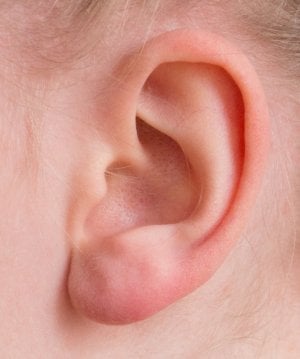Where do bacteria thrive? Scientists confirm the ‘grandma hypothesis’
Are you diligently cleaning behind your ears, between your toes, and in your belly button? If not, your grandma's timeless advice might be worth revisiting.
Researchers at George Washington University in the U.S. said that these often overlooked spots could serve as breeding grounds for bacteria, given their tendency to be neglected during wash time in comparison to more visible areas like arms and legs.
Keith Crandall, a Genomics Professor at the University, fondly recalled his grandma's persistent reminders to ‘scrub behind the ears, between the toes, and in the belly button’.
Inspired by this age-old wisdom, Professor Crandall led a hands-on experiment involving 129 graduate and undergraduate students in the same university.
Annually, from 2019 to 2023 (with a brief hiatus in 2021 due to the pandemic), they actively collected samples from behind their ears, between their toes, and in their belly buttons.
As part of their research, the team also swabbed their forearms and calves as control areas.
The research study revealed a higher diversity of microbes on the forearms and calves, suggesting a potentially healthier microbial community in these regions compared to others.
A healthier collection could indicate the presence of more bacteria types that are less likely to cause disease.
Conversely, areas like behind the ears, between the toes, and in belly buttons tend to be more moist and warm, providing an ideal environment for bacteria to thrive.
When specific bacteria dominate the microbiome, encompassing bacteria, fungi, and viruses throughout the body, they have the potential to disrupt the delicate balance crucial for health, explained Professor Crandall.
A shift in the microbiome toward harmful microbes can lead to skin conditions such as eczema or acne.
However, the microbiome composition varies across the body, comprising both beneficial and potentially harmful bacteria.
Thorough cleaning of these neglected areas, as advised by grandmothers through generations, can play a vital role in preventing such disruptions.
The study's findings, recently published in the journal Frontiers in Microbiology, shed light on the importance of maintaining a balanced microbiome for overall health.
It's important to give extra care to areas like behind the ears, between the toes, and the belly button. Often missed in daily routines, these spots can harbour dirt, sweat, and bacteria.
Here's how to effectively clean each:

Members, do you make it a habit to clean behind your ears, between your toes, and your belly button? If so, what's your cleaning routine, and how often do you maintain these areas?
Researchers at George Washington University in the U.S. said that these often overlooked spots could serve as breeding grounds for bacteria, given their tendency to be neglected during wash time in comparison to more visible areas like arms and legs.
Keith Crandall, a Genomics Professor at the University, fondly recalled his grandma's persistent reminders to ‘scrub behind the ears, between the toes, and in the belly button’.
Inspired by this age-old wisdom, Professor Crandall led a hands-on experiment involving 129 graduate and undergraduate students in the same university.
Annually, from 2019 to 2023 (with a brief hiatus in 2021 due to the pandemic), they actively collected samples from behind their ears, between their toes, and in their belly buttons.
As part of their research, the team also swabbed their forearms and calves as control areas.
The research study revealed a higher diversity of microbes on the forearms and calves, suggesting a potentially healthier microbial community in these regions compared to others.
A healthier collection could indicate the presence of more bacteria types that are less likely to cause disease.
Conversely, areas like behind the ears, between the toes, and in belly buttons tend to be more moist and warm, providing an ideal environment for bacteria to thrive.
When specific bacteria dominate the microbiome, encompassing bacteria, fungi, and viruses throughout the body, they have the potential to disrupt the delicate balance crucial for health, explained Professor Crandall.
However, the microbiome composition varies across the body, comprising both beneficial and potentially harmful bacteria.
Thorough cleaning of these neglected areas, as advised by grandmothers through generations, can play a vital role in preventing such disruptions.
The study's findings, recently published in the journal Frontiers in Microbiology, shed light on the importance of maintaining a balanced microbiome for overall health.
It's important to give extra care to areas like behind the ears, between the toes, and the belly button. Often missed in daily routines, these spots can harbour dirt, sweat, and bacteria.
Here's how to effectively clean each:
- Behind the ears. Dampen a face cloth with warm water and soap. Gently clean behind each ear, then rinse and pat dry.
- Between the toes. Soak your feet in soapy water briefly. Use a face cloth or brush to clean between toes, then rinse and dry thoroughly to prevent bacterial growth.
- Belly button. Dip a cotton bud in soapy water or alcohol. Clean inside the belly button, being careful with deep navels. Rinse and pat dry.
Key Takeaways
- Scientists at George Washington University confirm that areas behind the ears and between the toes harbour the most germs due to less frequent washing.
- In a four-year study with 129 students, these areas, including forearms, calves, and belly buttons, were swabbed (skipping 2021 due to the pandemic).
- Forearms and calves exhibited greater microbial diversity and potentially healthier collections than other areas.
- Problematic skin conditions like eczema or acne may arise when specific bacteria dominate the microbiome, but thorough cleansing of these areas can prevent such issues.










